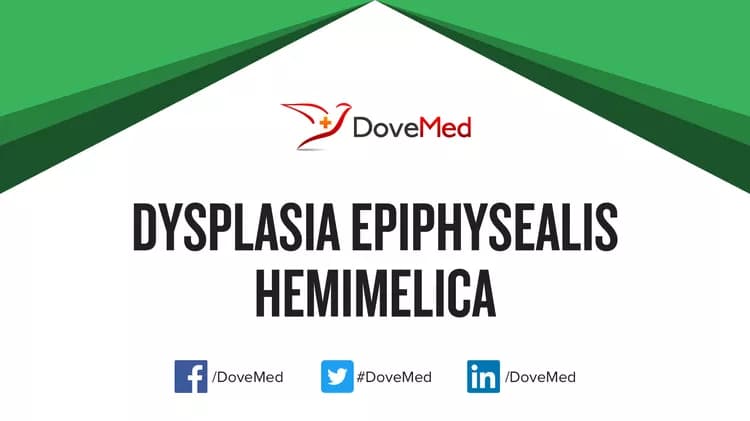What are the other Names for this Condition? (Also known as/Synonyms)
- DEH (Dysplasia Epiphysealis Hemimelica)
- Trevor Disease
- Trevor's Disease
What is Dysplasia Epiphysealis Hemimelica? (Definition/Background Information)
- Dysplasia Epiphysealis Hemimelica (DEH), or Trevor's Disease, is a rare condition that most commonly affects the epiphysis (the end) of long bones in children
- Early diagnosis and treatment are necessary to prevent joint dysfunction and deformity and may be surgical or non-surgical depending on the location and the symptoms
- Due to the progressive nature of this disorder and the chance of worsening deformity, patients should be followed until skeletal maturity
- The cause of Dysplasia Epiphysealis Hemimelica is not known
(Source: Dysplasia Epiphysealis Hemimelica; Genetic and Rare Diseases Information Center (GARD) of National Center for Advancing Translational Sciences (NCATS), USA.)
Who gets Dysplasia Epiphysealis Hemimelica? (Age and Sex Distribution)
- Dysplasia Epiphysealis Hemimelica is a very rare congenital disorder. The presentation of symptoms is noted in children
- Both males and females may be affected
- Worldwide, individuals of all racial and ethnic groups may be affected
What are the Risk Factors for Dysplasia Epiphysealis Hemimelica? (Predisposing Factors)
- Currently, no risk factors have been clearly identified for Dysplasia Epiphysealis Hemimelica
It is important to note that having a risk factor does not mean that one will get the condition. A risk factor increases one’s chances of getting a condition compared to an individual without the risk factors. Some risk factors are more important than others.
Also, not having a risk factor does not mean that an individual will not get the condition. It is always important to discuss the effect of risk factors with your healthcare provider.
What are the Causes of Dysplasia Epiphysealis Hemimelica? (Etiology)
The exact cause of Dysplasia Epiphysealis Hemimelica is presently unknown.
What are the Signs and Symptoms of Dysplasia Epiphysealis Hemimelica?
The signs and symptoms of Dysplasia Epiphysealis Hemimelica may include:
Very frequently present symptoms in 80-99% of the cases:
- Accelerated skeletal maturation
- Asymmetric growth
- Bone pain
- Exostoses
- Irregular epiphyses
- Joint stiffness
- Osteoarthritis
- Pes planus
- Tarsal synostosis
Frequently present symptoms in 30-79% of the cases:
- Genu valgum
- Genu varum
Occasionally present symptoms in 5-29% of the cases:
- Abnormality of the femoral neck
- Flattened femoral head
- Recurrent fractures
(Source: Dysplasia Epiphysealis Hemimelica; Genetic and Rare Diseases Information Center (GARD) of National Center for Advancing Translational Sciences (NCATS), USA.)
How is Dysplasia Epiphysealis Hemimelica Diagnosed?
Dysplasia Epiphysealis Hemimelica is diagnosed on the basis of the following information:
- Complete physical examination
- Thorough medical history evaluation
- Assessment of signs and symptoms
- Laboratory tests
- Imaging studies
- Biopsy studies, if necessary
Many clinical conditions may have similar signs and symptoms. Your healthcare provider may perform additional tests to rule out other clinical conditions to arrive at a definitive diagnosis.
What are the possible Complications of Dysplasia Epiphysealis Hemimelica?
The complications of Dysplasia Epiphysealis Hemimelica may include:
- Frequent fractures
- Severe skeletal defects
Complications may occur with or without treatment, and in some cases, due to treatment also.
How is Dysplasia Epiphysealis Hemimelica Treated?
There is no cure for Dysplasia Epiphysealis Hemimelica. The treatment is usually given to manage the signs and symptoms and any complications that develops.
How can Dysplasia Epiphysealis Hemimelica be Prevented?
- Currently, Dysplasia Epiphysealis Hemimelica may not be preventable, since the cause of the disorder is not known
- Active research is currently being performed to explore the possibilities for treatment and prevention of inherited and acquired genetic disorders
- Regular medical screening at periodic intervals with tests and physical examinations are recommended
What is the Prognosis of Dysplasia Epiphysealis Hemimelica? (Outcomes/Resolutions)
- The prognosis of Dysplasia Epiphysealis Hemimelica is dependent upon the severity of the signs and symptoms and associated complications, if any
- Individuals with mild conditions have better prognosis than those with severe symptoms and complications
- Typically, the prognosis may be assessed on a case-by-case basis
Additional and Relevant Useful Information for Dysplasia Epiphysealis Hemimelica:
The following DoveMed website link is a useful resource for additional information:
Related Articles
Test Your Knowledge
Asked by users
Related Centers
Related Specialties
Related Physicians
Related Procedures
Related Resources
Join DoveHubs
and connect with fellow professionals


0 Comments
Please log in to post a comment.